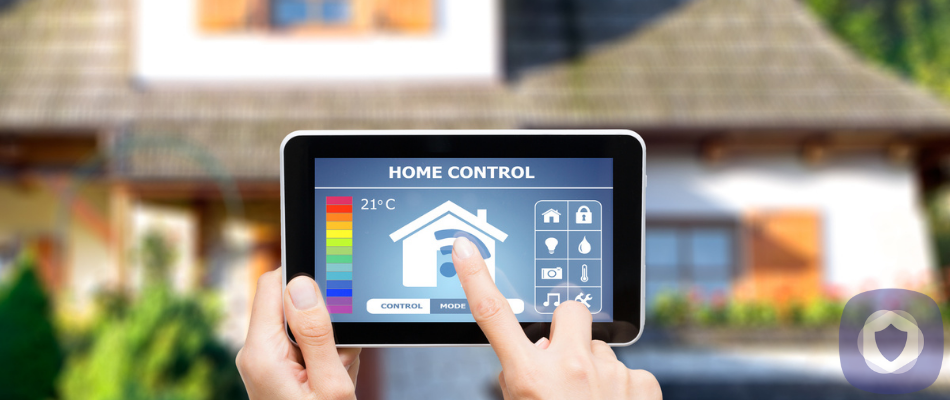The smart thermostat is a relatively recent invention, with the first one being released in 2007. Despite being a reasonably new technology, thousands have switched from manual programmable thermostats to advanced smart thermostats that you can control remotely with a smartphone app.
How do smart thermostats work?
With a regular thermostat, you use a dial to control the room’s temperature. The smart thermostat works with your heating systems boiler, the central thermostat control, and an app you download onto your cellphone. Therefore, it’s more efficient and user-friendly than using a traditional thermostat.
More advanced thermostats can learn your schedule, analyze and predict your behavior. It can detect when you’re on your way home and prepare your home’s temperature in advance.
As smart thermostats take your schedule and lifestyle into account, it automatically adjusts your home for your comfort. It can reduce your energy bills by turning off heating or air conditioning as soon as you leave the house.
The benefits of having a smart thermostat
With a smart thermostat, you can eliminate the hassle involved with managing your home’s climate and energy efficiency.
Some smart thermostats can adjust temperature settings automatically based on certain ambient conditions such as humidity. Aside from making your home comfortable for you, you can also save energy using analytics in the long run.
A smart thermostat is an excellent investment if any of the following apply to you.
- You have a busy schedule
- You want to reduce your energy bills
- You enjoy the convenience of a smart home system
Remote temperature control
Managing your home’s temperature remotely is appealing for those with busy schedules. You can turn off your home heating whether you’re outside your front door or on vacation in another country.
Even better, you can adjust the temperature of your home when you’re on your way home to ensure that it’s your desired temperature when you walk through the door. Busy people appreciate the smart thermostat more than most.
Monitoring usage
Installing a smart thermostat may give you energy savings in several ways. Not only will a smart thermostat let you remotely control your system – making it far more efficient and likely to save you money in the long run, you’re also provided with reports and analytics on your usage that will help you see where you can make the most savings. You can adjust your routine to save even more money if you choose to. The HVAC system is a money-drain in most modern homes; with a smart thermostat, you can turn this off when you leave home but turn it back on before you get home.
There are many benefits, but we only recommend that you get a smart thermostat if you don’t think you’ll be moving soon. Homeowners are the ones who’d benefit the most from a smart thermostat.
With that said, you can still install a smart thermostat with your landlord’s approval, but you should only do it if you know you’ll be staying long enough to make the investment worthwhile. It’s perhaps not cost-effective to install a smart thermostat if you’re only staying for a few months. You’ll save more money the longer your smart thermostat is installed.
Home automation
You can design a comprehensive home system that comprises several smart home devices, including a home security system if you desire. Some smart thermostats can be used with Amazon’s Alexa, Google Home, and Z-Wave technologies. That means you don’t even need your phone to adjust the temperature – you can use voice control. Some products, such as the Google Nest Learning thermostat, are compatible with a broader system.
Smart thermostat types
When it comes to smart thermostats, you can choose from several different types. You should consider the strengths and weaknesses of each before you decide which is the best smart thermostat type for your home.
Geofencing thermostat
Geofencing thermostats use GPS tracking to create a parameter around your home. Once you exit the parameter, the thermostat will turn off or otherwise adjust the heating/cooling in your home to save energy. When you re-enter the parameter upon returning home, your thermostat will get to work adjusting your home’s temperature for your comfort. Your parameter is usually adjustable. Most customers find a 500m parameter to be ideal.
Learning thermostats
Learning thermostats can predict when the house is likely to be empty or occupied according to the usual behavior of the occupants. Learning thermostats will pre-heat or cool the house to ensure the comfort of the occupants when they arrive home. These smart thermostats can make gradual changes in line with your schedule and lifestyle.
Connected thermostats
You can adjust your heating/cooling settings with another internet-capable smart device. You can control these thermostats through a WiFi or internet connection for remote programming and management. Typically, this thermostat type won’t provide analytics.
You can still reduce energy usage using this thermostat type as you can turn off your heating/cooling system when you’re out.
Zoned systems
With a zoned system, you’ll be given the ability to control the temperature in specific rooms rather than the whole house. You can exclude specified areas whenever you’d like. This allows you to customize and save on energy costs. Most customers will exclude bedrooms/upstairs during the day and the living area/downstairs while the household sleeps, but it’s up to you.
Learning zoned system
Learning zoned systems are very advanced; they combine the principles of a learning thermostat and a zoned system. Learning zoned systems can begin to anticipate when each house room is typically occupied and schedule the heating/cooling based on that information. These thermostats can usually provide money-saving analytics, too.
Summing up
If you want to save money on your electric bill and start a smart home ecosystem of your own, you should consider getting a WiFi thermostat. Smart thermostats are easy to use with a mobile app and home WiFi connection and can save you a lot of money by reducing your energy use. Most thermostats will pay for themselves and more in the first few years.
This article has been reviewed and approved by Officer Banta.

Officer Banta is the official SecurityNerd home security and safety expert. A member of the Biloxi Police Department for over 24 years, Officer Banta reviews all articles before lending his stamp of approval. Click here for more information on Officer Banta and the rest of our team.

